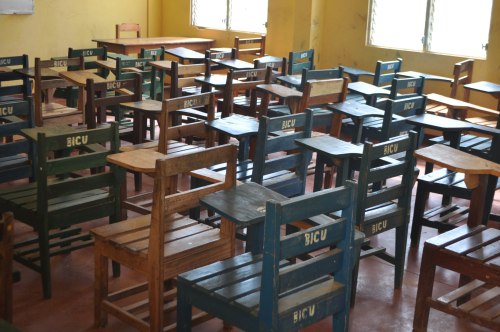
The Mayor of Puerto Cabezas (left) cuts out of class to greet us.
PUERTO?CABEZAS?- The Mayor of Puerto Cabezas came out of his Saturday law class to greet us in the hallway. As little kids sold us bags of fruit outside the classrooms, arrangements were made for a more formal audience before we left town. Today we were at the local campus of Bluefields Indian Caribbean University where among other things, they are trying to educate local leaders in the law.
The University sees itself as answering the needs of its region accommodating more than 2,500 students in their degree programs. Prior to 1992 no university existed in the Atlantic Coast of Nicaragua. Those with academic ambition had to travel to the Pacific coast to study. Given these are five-year?programs, few professionals ever made their way back to Puerto Cabezas.
One official told us ?you could count on your fingers the number of professionals? that worked in the region prior to 1992.
For medicine programs, the university specifically?admits students based on geography, calculating that someone with a nursing degree is far more likely to eventually work in a remote location like Waspan, Bonanza or Siuna if they originally came from these communities.
The University also makes a point of admitting students from over the border in Honduras. Despite the poverty of Puerto Cabezas, the university insists that young people in nearby Honduras have it even worse.
?University officials say they strongly believe that education is a right and do all they can to accommodate students. While the $35/year tuition may not be overwhelming, the cost of not working and living in a town far away from your family can be a daunting challenge.

Classroom in the former hospital.
The Puerto Cabezas campus was a cooperative agreement between Bluefields and the Moravian Church. The church has converted their former hospital in the city into a university after the Nicaraguan government had taken responsibility for health care.
As part of that agreement the university agreed to offer a Bachelor?s degree?in theology. Many of the programs the school operates would not be out-of-place in a Canadian College setting, the emphasis being on economic development and the needs of the community.
That includes educating teachers for the region?s high schools. The university realizes that their future is tied up with a strong primary and secondary school system in their feeder communities.
The school particularly wants to address the high rate of violence in the region, picking up on the discussions we had with AMICA the day before. Given the violence is deeply ingrained in the community, the university is sensitive about addressing the issue while remaining respectful to the community.
As a relatively young institution ? Bluefields Indian Caribbean University was only established in Puerto Cabeza in 1995 ? the university would like to set up relationships with other academic institutions internationally, including the possibility of working on exchange programs.

Visiting a nearby museum to learn more about indigenous peoples.
Earlier in the day we visited a partner of AMICA. While AMICA focuses on the legal side of violence against women and children, it is the Nidia White Shelter that takes in AMICA?s clients when they have no place to go.
The morning we visited Nidia White the shelter was full of children, many who had suffered physical and sexual abuse at the hands of a family member. While the offices face onto the street in behind a tall chain link fence topped with barbed wire, the shelter itself is in a newer building at the back of the property.
The shelter is fortunate to have a psychologist on staff given the trauma women and children face before arriving on the shelter?s doorstep. Victims often have difficulty with their self-esteem ? childen often feel their body has no value after being sexually abused.
In Nicaragua mental illness gets little attention and the shelter can be called upon the support the hospital by sharing their professional resources.
Given the economic plight of women in the region, the shelter must also prepare women who are likely to return to the same circumstance in which they or their children were abused. The shelter advises them to keep their legal documents close at hand, to always have a suitcase packed and know which window they can easily get out of should the situation arise again. Few women are able to economically go out on their own, although some escape an abusive situation by moving in with relatives.
They also tell them to find someone they can talk to. Breaking the silence is an important piece of advice.
Late afternoon it was back to AMICA, where two historians were waiting for us. The Misktu?indigenous people were here long before others arrived in Nicaragua. At one point there were 33 different indigenous peoples living in the region. Today there are three.
Despite 500 years of colonialism, the Misktu?are proud of maintaining their language and cultural identity. They see the present model of autonomous government as one other indigenous groups may want to emulate, including the Zapatistas in Mexico.
The historians say the Misktu needs more than cultural autonomy, they need meaningful economic autonomy too.
Tomorrow: We head into the countryside around Puerto Cabezas.
Other posts in this series:
Day 1: In The Flash Of This Moment
Day 2: A Sense of Persistence?Against Tremendous Odds
Day 3: And Then The Chicken Walked In
Day 4: Love and Friendship on Valentine?s Day
Day 5: The Other Nicaragua
Source: http://diablogue.org/2013/02/16/nicaragua-day-6-the-mayor-cuts-class-to-greet-us/
daytona artie lange nascar daytona 2012 kasey kahne angelina jolie right leg saving face academy award winners
No comments:
Post a Comment